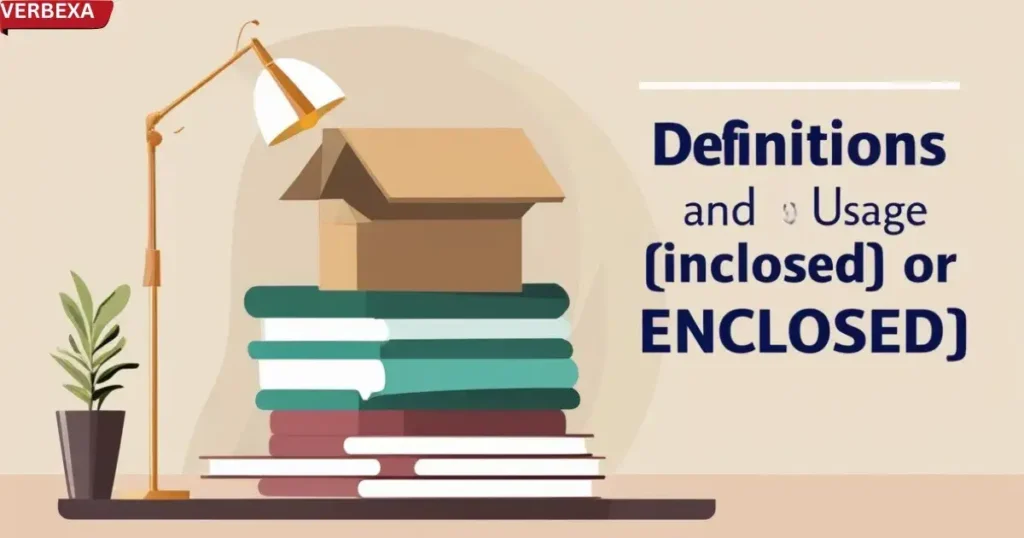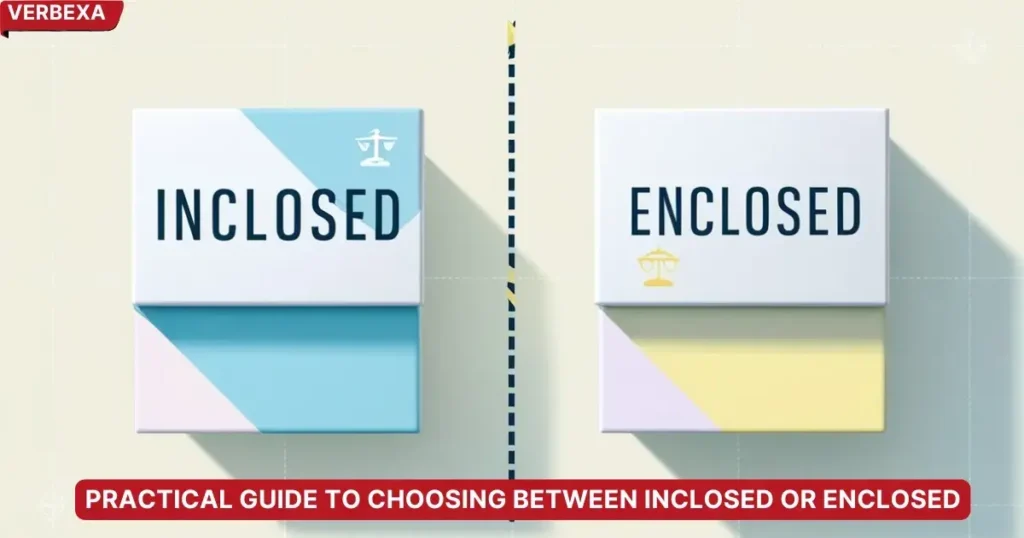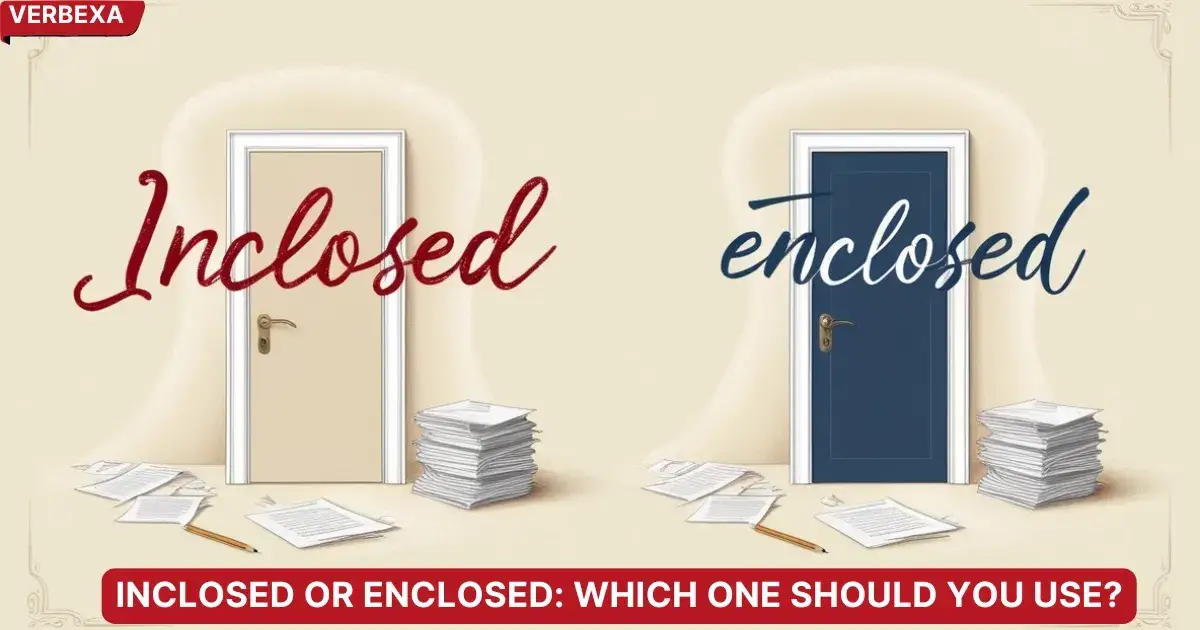The confusion between inclosed or enclosed has puzzled writers for centuries. This comprehensive guide will help you understand the correct usage and spelling of these commonly mixed-up terms. If you’ve ever wondered “how do you spell enclosed” or struggled with “inclose vs enclose,” you’re not alone.
Quick Answer
Enclosed is the modern, correct spelling. Inclosed is an archaic variant that’s no longer in standard use. When in doubt, use “enclosed.”
Understanding the Difference
The debate between enclosed or inclosed largely stems from historical language evolution. While both terms share the same meaning, enclosed has emerged as the standard spelling in modern English. This article will explore the distinctions and proper usage of these terms.
Definitions and Core Usage

Before diving into the nitty-gritty of inclosed or enclosed, let’s define each term:
Inclosed
- Definition: “Inclosed” is an archaic or obsolete spelling of the modern word “enclosed.” While it was once in common usage, it has since fallen out of favor, and its use today is rare and considered incorrect in most contexts.
- Modern usage: Found mainly in historical texts inclosed in archives.
- Grammar: “Inclosed” is typically used as a past tense verb (e.g., “The letter was inclosed”) or as an adjective describing something surrounded or enclosed by something else.
- Example: “The document was inclosed in the envelope.”
Enclosed
- Definition: “Enclosed” is the correct, modern spelling. It means to surround something, place something inside something else, or keep something contained within boundaries.
- Modern usage: Widely accepted in all formal and informal contexts.
- Grammar: Like “inclosed,” “enclosed” is a past tense verb, but it is the term preferred in all contemporary usage. It can also be an adjective.
- Example: “Please find the enclosed document for your review.”
The key takeaway here is that inclosed or enclosed both come from the same root verb, but “enclosed” is the proper, modern spelling that you should use in everyday writing.
Inclosed or Enclosed Synonym
Both inclosed and enclosed have similar meanings. Let’s look at a list of synonyms for each:
Synonyms for Inclosed:
- Surrounded
- Confined
- Encased
- Encompassed
- Sealed
- Enshrouded
- Secured
- Imprisoned
- Wrapped
- Closed in
Synonyms for Enclosed:
- Surrounded
- Contained
- Bound
- Encased
- Confined
- Secured
- Wrapped up
- Sealed
- Immured
- Cased
While there are overlapping synonyms, it’s clear that the usage of “enclosed” is much more widely accepted in modern English. As such, you will more commonly encounter words like “contained” and “sealed” associated with the term enclosed.
Comparison Table: Inclosed vs Enclosed
To help visualize the differences, here’s a comparison table that highlights key distinctions between inclosed and enclosed.
| Aspect | Inclosed | Enclosed |
|---|---|---|
| Definition | An archaic spelling of “enclosed.” | To surround or place inside something. |
| Usage | Rarely used in modern contexts. | Commonly used in both formal and informal writing. |
| Grammar Role | Verb (past tense) or adjective. | Verb (past tense) or adjective. |
| Common Contexts | Old texts, formal letters (historically). | Modern formal and informal writing, contracts, emails, documents. |
| Spelling Preference | Outdated and incorrect today. | Correct spelling in modern English. |
| Frequency of Use | Very rare in contemporary writing. | Widely accepted and used in all contexts. |
When to Use Each Term
Understanding when to use inclosed or enclosed requires considering the context.
- Inclosed:
- This term is generally not recommended in modern usage. While it may still appear in old literature or historical documents, it should be avoided in current communication.
- It is best to reserve inclosed for historical or archaic contexts when writing about old English texts or quoting older works.
- Enclosed:
- This is the preferred spelling in all modern contexts. Whether you’re enclosing a document in an envelope or discussing something surrounded by a fence, enclosed is the correct choice.
- You should use enclosed when sending a letter, attaching a document in an email, or writing formal business letters.
Practical Guide to Choosing Between Inclosed or Enclosed:

- Formal Writing: Always use enclosed. In letters, contracts, and official communications, enclosed is the modern, widely accepted term.
- Emails and Digital Communication: Use enclosed when attaching files or referring to documents that are part of the message. For instance, “Please find the enclosed document.”
- Historical Texts: If you are quoting an old document, such as a letter from the 19th century, you may encounter inclosed. In this case, you are simply preserving the original spelling.
Inclosed or Enclosed Examples & Useage
Let’s make this clearer with some everyday examples where inclosed or enclosed might appear:
Example 1: Enclosed in a Business Letter
“I am writing to confirm that the payment for invoice #12345 is enclosed. Please process this payment as soon as possible.”
In this case, enclosed is the correct choice because it refers to the physical document (payment) that is part of the letter.
Example 2: Enclosed Document in an Email
“Please find the enclosed document for your review. Let me know if you have any questions.”
Here, enclosed is used to refer to the attachment in the email. It is formal, correct, and widely accepted.
Example 3: Historical Use of Inclosed
“In the 18th century, it was common to see a letter inclosed with a wax seal for security.”
This is a historical example where inclosed might still be used to reflect old writing conventions.
Conclusion
The distinction between inclosed or enclosed is subtle but important. In today’s world, enclosed is the correct spelling and should be used in most cases, whether you’re writing formal business letters, emails, or simply enclosing a document in an envelope. The inclosed form is considered archaic, and while it may still appear in historical contexts or old texts, it is no longer a preferred choice.
Understanding when and how to use enclosed or inclosed can help you communicate more effectively and with precision. Remember, if you’re ever in doubt, enclosed is always the safe bet!
By following this guide and using the modern form enclosed, you’ll ensure your writing remains clear, correct, and professional.

This author is a passionate linguist and grammar enthusiast, dedicated to helping individuals master the art of language. With years of experience in teaching and editing, she brings clarity and precision to every sentence. Tina’s mission is to empower writers of all levels to express themselves with confidence and excellence.

